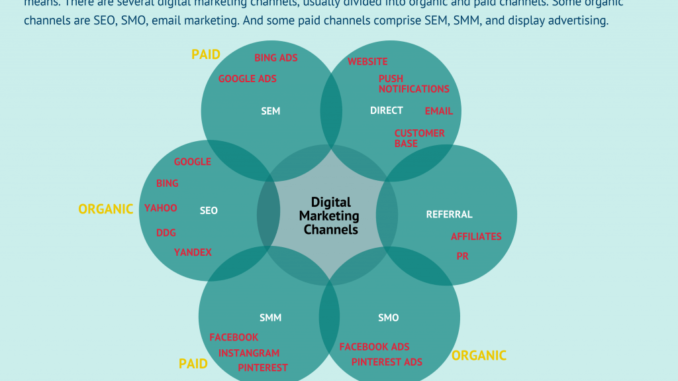
A digital channel is a marketing channel, part of a distribution strategy, helping an organization to reach its potential customers via electronic means. There are several digital marketing channels, usually divided into organic and paid channels. Some organic channels are SEO, SMO, email marketing. And some paid channels comprise SEM, SMM, and display advertising.
Quick intro do digital marketing channels
To build a successful distribution strategy companies need to leverage on digital channels to reach their potential customers.
Whether a company sells a physical or digital product, digital marketing channels can be an incredible source of continuous growth for the business, thus enabling to build a viable business model.
However, each channel type will require an understanding of the underlying platform, the kind of incentives created for users on those platforms and how users interact.
Organic vs. paid
A first distinction is between organic vs. paid channels. Organic channels are those who do not require to pay for attention. That doesn’t mean organic channels are less expensive. Indeed, a way to grow organically is through content developemtn.
Producing great content can be quite expansive. Therefore, organic simply means that you can gain visibility and interests from potential customers without paying a third-party platform to be featured.
An example is an SEO, or search engine optimization, where a platform like Google ranks your content because it perceives it as high quality. Thus, enabling users to get through you continuously through that content.
A paid channel instead, requires a budget to enable a third-party platform to feature that content to users. When budget is over so the content will run out of visibility. An example is search engine marketing. You pay Google on a pay-per-click basis to feature your content on top of its listings.
Direct vs. indirect
A direct digital marketing channel enables potential customers to get to you without middlemen. One example is people who type directly your website name on their browser, thus coming to your site.
An indirect channel example is someone finds you through a social media post, which gets featured by Facebook’s algorithms on the users’ feed. If Facebook pushes down the reach of that same post none will find you anymore.
In the former case, potential customers get direct access to your brand. In the latter, users get to know you via a third-party platform.
Digital marketing channels
Let’s look now at some of the key digital marketing channels:
Direct
In a direct digital marketing channel potential customers get directly to your product. Some examples include:
- Customer base: an existing set of customers with whom you have direct contact.
- Email list: a list of contacts built over the years which you can contact directly.
- Website direct traffic: a portion of website traffic comes from people directly young (or having your site saved as a favorite) thus bypassing search engines.
- Push notifications: in some instances websites also collect contacts by enabling push notifications. In that case, when content is out it will reach directly those contacts.
Referral
Referrals are channels used to bring visibility to your business beyond search, or social media. Some examples include:
- Affiliate, parters’ websites: you can incentivize other websites and partners to bring traffic or conversions back to your business by structuring partnerships or revenue share.
- PR campaigns: if a media website features your product you will gain traffic as a result.
- Backlinks: if your content is great, other websites might link to it, thus bringing it traffic.
SEO
Search engines like Google, Bing, Yahoo or DuckDuckGo, still have a large portion of their listings based on organic results (websites featured without paying on a performance basis).
This is at the core of search engine optimization activities.
SEM
Search engines like Google, Bing, Yahoo or DuckDuckGo primarily make money via advertising revenues. Thus, companies pay them to be featured on top of their search results (there are also other factors affecting paid rankings).
A search engine marketing strategy looks at sponsoring your content by – usually – paying on a performance basis.
Platforms like Google Ads help with that.
SMO
In social media optimization companies curate their pages and content on social media platforms (Facebook, Instagram, TikTok, Twitter, Pinterest, Snapchat) to gain organic (unpaid) visibility by building a loyal audience over time.
SMM
The same social media platforms we saw above primarily make money via paid advertising. Companies like Facebook, Instagram, Pinterest have built advanced advertising platform which give companies the ability to segment their audiences in many ways.
Key takeaways
- Digital marketing channels are electronic ways to reach potential customers.
- There are different digital channels (organic vs. paid, or direct vs. indirect) and they also change according to the ever-evolving digital landscape.
- An organic channel is usually earned through developing quality content that gets a continuous flow of traffic. Paid channels enable companies to push their products via third-party platforms.
- Direct channels enable companies to reach directly their existing or potential customers. Indirect channels instead enable an organization to reach potential customers via a third-party distribution platform.
- Some of the digital marketing channels comprise SEO, SEM, SMO, and SMM.
Handpicked related resources:
The post Digital Marketing Channels Types And Platforms appeared first on FourWeekMBA.
